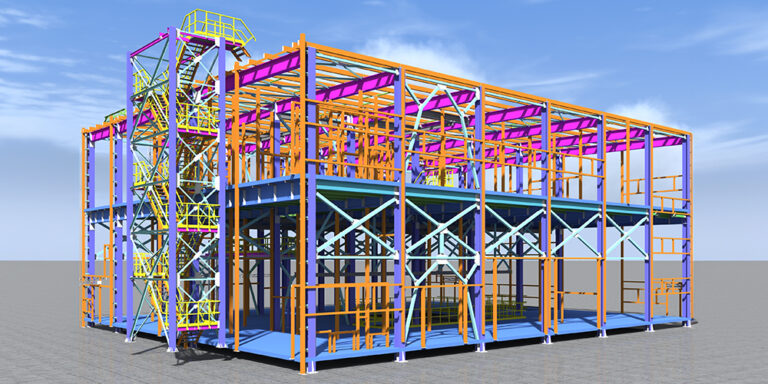— 8 min read
A Guide to ISO 19650 for Construction Professionals

Last Updated Aug 28, 2025

Tom Noctor
Senior Product Manager, International
16 articles
Having worked in construction for many years both on the ground as an electrician and in the design space in roles such as BIM Manager, I witnessed the highly inefficient operations of our industry and also the amount of waste generated from project delivery. I am a Digital Construction Technologies advocate @Procore Technologies, supporting and guiding the construction industry in adopting/utilising technology to deliver projects in a lean sustainable manner.

Nicholas Dunbar
Content Manager
62 articles
Nick Dunbar oversees the creation and management of UK and Ireland educational content at Procore. Previously, he worked as a sustainability writer at the Building Research Establishment and served as a sustainability consultant within the built environment sector. Nick holds degrees in industrial sustainability and environmental sciences and lives in Camden, London.
Last Updated Aug 28, 2025

ISO 19650 is an international standard for managing building information models (BIM), digital drawings, and other construction data. It offers guidelines for organising and digitising information throughout the lifecycle of construction projects. By following these guidelines, project teams can streamline communication and collaboration, all whilst boosting efficiency and accuracy across all project phases.
Table of contents
From PAS 1192-2 to ISO 19650
Introduced in 2013, PAS 1192-2 was initially a UK-specific standard focusing on managing information during the delivery phase of BIM projects. As the construction industry became more global, the need for a universally accepted framework grew. In 2019, PAS 1192-2 transitioned into ISO 19650, standardising practices internationally and bringing consistency across different countries and teams.
The Six ISO 19650 Components
ISO 19650-1: Concepts and Principles
ISO 19650-1 outlines the concepts and principles for strategic information management. It targets decision makers involved in the procurement, use, and management of built asset information. By establishing a strategic framework, it makes sure that all information supports the overall organisational goals, creating a cohesive approach to information management.
ISO 19650-2: Delivery Phase of the Assets
ISO 19650-2 focuses on the delivery phase of a building and the necessary management processes. This section is essential for design teams, and construction companies who are responsible for implementing effective information management throughout a project. It provides a roadmap for handling information, coordinating models, and ensuring quality control - linking strategic goals to operational actions.
ISO 19650 Part 2 provides guidance on the metadata for different construction packages, such as architectural, electrical, mechanical, and plumbing. It supports status coding, which ensures that the information issued to the system is suitable for coordination and approval. This guarantees that the right people receive the right information at the right time. Each country can provide its own variations of the naming conventions and status coding via an Annex. For example, the UK variation is BS EN ISO 19650-2 and for Ireland, it is IS EN ISO 19650-2.

Tom Noctor
Senior Product Manager, International
Procore Technologies
ISO 19650-3: Operational Phase of the Assets
ISO 19650-3 addresses the management of information during the operational phase of an asset. This part is crucial for facility managers, owners, and operators as it provides guidelines for managing and maintaining asset information post-construction. It ensures that accurate, up-to-date information is available throughout the asset's operational lifecycle, supporting effective maintenance, repairs, and renovations.
ISO 19650-4: Information Exchange
ISO 19650-4 focuses on the processes and requirements for information exchange across project stages. It sets standards for data formats, exchange protocols, and information delivery, providing clear routes of communication between all stakeholders. This is key for interoperability between different software systems and platforms, which is crucial for collaborative project environments.
ISO 19650-5: Security-minded Approach to Information Management
ISO 19650-5 introduces a security-minded approach to information management. This part emphasises the importance of protecting sensitive information from unauthorised access, cyber threats, and data breaches. It provides guidelines for implementing security measures, ensuring that all information exchanged and stored during the project's lifecycle is safe. This key for safeguarding intellectual property and maintaining client trust.
ISO 19650-6: Health and Safety Information
ISO 19650-6 - which is still under development - deals with the integration of health and safety management principles within the information management framework. This part provides guidelines for incorporating health and safety data into BIM models and other project information. This means that safety considerations are integrated into all phases of the project, from design through to construction and operation, reducing risks and promoting a safer working environment.
Learn about the future of the built environment - Read Procore's Future State of Construction report
Learn how contractors, subcontractors, and project teams can take advantage of new opportunities to boost efficiency and profitability over the next decade. Download the report to get your roadmap to the future state of construction.

Benefits of ISO 19650 in Construction
Global Standards for Local Projects
ISO 19650 bridges local practices with global standards, levelling the approach to managing construction projects across different cultures and regions. This allows for collaboration between international and local teams whilst enabling local projects to align with global best practices - making them competitive on the international stage.
Enhanced Communication and Collaboration
One of the key benefits of ISO 19650 is the improvement in communication and collaboration among stakeholders. Clear guidelines on data management guarantee that architects, engineers, contractors, and clients are aligned. Improved communication prevents misunderstandings and promotes a cooperative working environment.
ISO 19650 Part 2 provides guidance on the metadata for different construction packages, such as architectural, electrical, mechanical, and plumbing. It supports status coding, which ensures that the information issued to the system is suitable for coordination and approval. This guarantees that the right people receive the right information at the right time. Each country can provide its own variations of the naming conventions and status coding via an Annex. For example, the UK variation is BS EN ISO 19650-2 and for Ireland, it is IS EN ISO 19650-2.

Tom Noctor
Senior Product Manager, International
Procore Technologies
Increased Efficiency and Cost Savings
Standardising information management processes under ISO 19650 reduces redundancies and errors. By streamlining workflows, construction projects can be executed more efficiently, leading to cost savings. This efficiency is particularly beneficial in complex projects where many stakeholders and high volumes of data are involved.
Improved Quality and Consistency
Consistent information handling under ISO 19650 means that data is accurate and reliable. This leads to higher quality outcomes and uniformity across projects, reducing the likelihood of rework. Reliable data supports better decision-making, making the project better overall.
One of the key compliance aspects of ISO 19650 is file-level access, meaning that access to documents is granted based on metadata. This makes certain that end users have access to relevant and approved information.
Compliance and Competitiveness
Observing international standards assures clients and partners of a commitment to best practices in information management, positioning any complying business as a reliable and forward-thinking organisation.
Stakeholders and Compliance
Identifying Key Stakeholders
Compliance with ISO 19650 involves various stakeholders, each playing a crucial role in the information management process. These stakeholders include:
- Architects and designers: responsible for creating and managing digital models and documents.
- BIM managers: oversee the application of BIM processes during construction.
- Project Managers: coordinate between different stakeholders and facilitate compliance.
- Owners and developers: require managed information for asset maintenance and operation.
- Contractors and subcontractors: use managed information for construction planning and execution and support the creation of construction drawings in Design-Build projects.
Roles and Responsibilities
Each stakeholder has specific roles and responsibilities that lead to smooth information management:
- Architects and designers: make sure that all designs and related documents are created and stored according to ISO 19650 standards.
- BIM managers and contractors: implement BIM processes and help all workers adhere to the standards during construction.
- Information Managers: oversee compliance and confirm that documentation is up to date and accessible.
- Owners and developers: specify requirements based on standards and verify compliance to facilitate future asset management.
Steps to Compliance
Getting Started with ISO 19650
Achieving compliance with ISO 19650 involves a structured approach. Here’s a step-by-step guide to get started:
- Educate your team: confirm that key project members understand the ISO 19650 standards through training sessions or workshops.
- Assess current practices: evaluate your current information management practices and identify areas that need adjustment.
- Develop an Implementation Plan: create a detailed plan that outlines how your organisation will adapt its processes to comply with ISO 19650.
- Update tools and systems: make sure that the software tools and systems used for information management are capable of complying with the standards.
- Implement procedures: roll out the new or revised procedures according to your plan. This includes training all participants.
- Monitor and adjust: regularly review your practices against the ISO 19650 standards and make necessary adjustments.
- Document compliance: maintain records of compliance efforts and results for internal audits and external validations.
Companies undergo audits by third-party consultants to ensure compliance with standards like ISO 19650. Some have advanced teams and might not need external audits, but others rely on consultants for maintaining compliance with ISO 19650, ISO 9001, and health and safety regulations.

Tom Noctor
Senior Product Manager, International
Procore Technologies
Tools and Resources
Essential Tools for ISO 19650
The right tools and resources are vital for achieving and maintaining compliance with ISO 19650:
- BIM software: programs that support Building Information Modeling processes, such as Autodesk Revit, facilitate compliance.
- Training programs: regular training helps everyone to understand their role in maintaining compliance.
- Consultants and experts: experts in ISO 19650 can provide valuable insights and help troubleshoot specific issues.
- Compliance checklists and templates: standardised checklists and templates help verify that nothing is overlooked. Documentation of BIM Processes support compliance related to achieving ISO19650 accreditation.
- Online platforms and forums: engaging with online communities focused on ISO 19650 provides support, insights, and updates.
Using Technology
Emerging technologies play a significant role in enhancing compliance:
- Cloud computing: enables real-time data sharing and collaboration, ensuring data consistency and availability.
- Artificial intelligence: predicts project risks, automates routine tasks, and certifies standards are followed throughout the project lifecycle.
- Blockchain: provides secure and transparent data storage and sharing, increasing trust in data.
Certification in ISO 19650
Training and Certification Resources
To achieve ISO 19650 certification, training and certification resources are essential:
- Official training courses: look for accredited training providers like the British Standards Institution (BSI) or the International Organization for Standardization (ISO).
- Online learning platforms: websites such as Coursera, LinkedIn Learning, or Udemy offer flexible courses on ISO 19650.
- Workshops and Seminars: Provide hands-on learning and networking opportunities from experts in the field.
Achieving Certification
Assess Current Compliance Level
Conduct an internal review or external audit to understand where your organisation stands
Identify Training Needs
Determine gaps and select appropriate training programs.
Select a Certification Body
Choose a reputable and accredited certification body.
Undergo Formal Assessment
Audit processes and systems for compliance.
Maintain Certification
Ensure ongoing compliance and regular re-assessment to adhere to standards
Categories:
Written by

Tom Noctor
Senior Product Manager, International | Procore Technologies
16 articles
Having worked in construction for many years both on the ground as an electrician and in the design space in roles such as BIM Manager, I witnessed the highly inefficient operations of our industry and also the amount of waste generated from project delivery. I am a Digital Construction Technologies advocate @Procore Technologies, supporting and guiding the construction industry in adopting/utilising technology to deliver projects in a lean sustainable manner.
View profileReviewed by

Nicholas Dunbar
Content Manager | Procore
62 articles
Nick Dunbar oversees the creation and management of UK and Ireland educational content at Procore. Previously, he worked as a sustainability writer at the Building Research Establishment and served as a sustainability consultant within the built environment sector. Nick holds degrees in industrial sustainability and environmental sciences and lives in Camden, London.
View profileExplore more helpful resources

Construction Management Contracts: A Complete UK Guide
Managing construction contracts can lead to an extensive physical paper trail. Sharing contracts, getting signatures and managing timelines is difficult when teams and clients are scattered across job sites and...

Key Differences Between Contractors & Subcontractors
In UK commercial construction, main (or principal) contractors engage directly with project owners to deliver complete construction programmes, while subcontractors perform specific scopes of work under the main contractor’s management....

The Role of RFPs in UK Construction Projects
Requests for Proposals (RFPs) are a core document for construction procurement in the United Kingdom. Effective RFPs align expectations, establish clear evaluation criteria, and create accountability between clients and contractors....

Financial Management in Construction Projects
Effective financial management can make or break construction projects. Teams that master budgeting, cash flow and cost control are better positioned to deliver projects on time, within budget and with...
